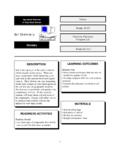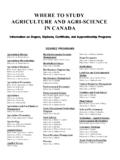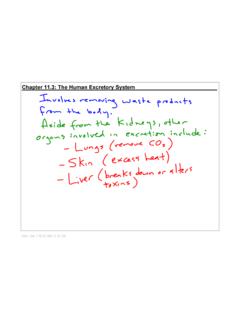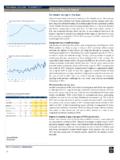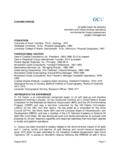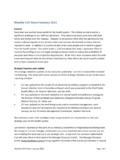Transcription of Grade 10-12 Soil Erosion
1 Agri-science Resources Science for High School Sciences Grade 10-12 . soil Erosion Physics Classroom Physics Individual reading DESCRIPTION LEARNING OUTCOMES. soil Erosion is a major problem in Students will: Agriculture. Tonnes of soil are lost from learn how damaging soil Erosion can be to fields every year. This not only reduces crop agriculture and the environment production, the soil acts as a pollutant to learn how to estimate the rate of soil loss rivers, lakes, and other water systems. soil in a field Erosion can be controlled with the proper techniques. This article describes soil Erosion and some methods of prevention. READINESS ACTIVITIES MATERIALS. Students should: Copy of article find any fields in their area that are highly calculator prone to soil Erosion and determine the cause 18.
2 soil Erosion Agri-science Resources for High School Sciences Physics Introduction soil is the top layer of the earth's surface that is capable of sustaining life. Therefore, soil is very important to farmers, who depend on soil to provide abundant, healthy crops each year. One major problem in agriculture is soil Erosion . soil Erosion is the deterioration of soil by the physical movement of soil particles from a given site. Wind, water, ice, animals, and the use of tools by man are usually the main causes of soil Erosion . It is a natural process which usually does not cause any major problems. It becomes a problem when human activity causes it to occur much faster than under normal conditions.
3 Facts and Figures Worldwide, farmers are losing an estimated 24 billion tonnes of topsoil each year. In developing countries Erosion rates per acre are twice as high as the standard, partly because population pressure forces land to be more intensively farmed. Although soil Erosion is a physical process, it also affects productivity and growth. Reductions in yield of up to 50%. have been documented on severely eroded soils in Ontario. When soils are depleted and crops receive poor nourishment from the soil , the food provides poor nourishment to people. Losses of soil take place much faster than new soil can be created. It takes thousands of years to form just a few centimetres of soil .
4 The difference between creation and loss represents an annual loss of to 10 tonnes per acre worldwide. soil Topsoil contains most of the soil 's nutrients, organic matter, and pesticides. soil Erosion causes these substances to move also. What is left behind is soil with poorer structure, lower water-holding capacity, different pH values, and low nutrient levels. Therefore, fertilizers and organic matter must be added in an attempt to restore the soil to its original composition. The soil also has a lower resistance to drought. 19. soil Erosion Agri-science Resources for High School Sciences Physics Where does it go? Much of the eroded soil is deposited either in low areas of the field or it moves off the farm and eventually enters drainage ditches, streams or rivers.
5 soil that enters a watercourse reduces water quality, reduces the efficiency of drainage systems and the storage capacity of lakes. soil that settles in water systems is called sediment. Accumulation of sediment often requires that it be cleared out manually, which costs money. Sediment fills rivers and reservoirs and reduces their capacity to hold flood waters. Sediment is considered to be a major pollutant. It can inhibit fish spawning and block the sunlight necessary to plant life. Increased runoff of chemical and nutrients from farmers fields must be removed in order for water to be safe to drink. Geographic Location The severity of soil Erosion can vary from place to place.
6 Wind and water are the main causes of soil Erosion . The faster either moves and the amount of plant cover available for protection are two main factors associated with Erosion . Wind Erosion is a more common problem in dry, windy regions, with a smooth, flat terrain. Water Erosion is a problem in wet regions with a sloping or hilly terrain. A significant portion of land used for potato production in Atlantic Canada is vulnerable to Erosion . 20. soil Erosion Agri-science Resources for High School Sciences Physics Erosion Factors The vulnerability of a field to soil Erosion is dependent on a number of factors: - The climatic conditions of the area - the proportion of sand, silt and clay sized particles in a particular soil - the organic matter level - the water permeability of the soil - the length and slope of the field - amount of crop rotation - direction of cultivation Protection It is vegetation that keeps soil from eroding.
7 This is because soil is usually covered with shrubs and trees, by dead and decaying matter or by a thick mat of grass. The root systems of plants is able to hold the soil together. Plants slow down water as it flows over the land and it allows much of the rain to soak into the ground. Plants also break the impact of a raindrop before it hits the soil . This reduces water Erosion . When this covering is stripped away through deforestation, over-grazing, ploughing and fire, soil Erosion is greatly accelerated. Over-cultivation and compaction cause the soil to lose its structure and cohesion and it becomes more easily eroded. Soils with high clay content are more cohesive and allow soil particles to stick together.
8 soil with more clay are less vulnerable to Erosion than soil with high sand or silt content. 21. soil Erosion Agri-science Resources for High School Sciences Physics Prevention There are a number of other conservation practices which can be used by farmers. Any single conservation practice can significantly decrease soil Erosion rates. Combining a number of soil conservation practices is often more effective. The ideal goal would be to achieve a soil loss rate of tonnes/ha/year. This is roughly the rate at which soil can rejuvenate itself. Making sure there are always plants growing on the soil and that the soil is rich in organic matter are two key methods in prevention.
9 Organic matter binds soil particles together which reduces Erosion . Organic matter in soil can be increased with crop rotation or by incorporating organic fertilizers. Crop rotation is also effective at enhancing soil structure. There are also many other methods used by farmers to reduce soil Erosion . Mulching is one example. It involves spreading hay or straw over a field as a substitute for a cover crop. Exercise: Calculation of Erosion Rates soil conservationists around the world use the Universal soil Loss Equation to estimate soil Erosion rates by water. The equation provides an estimate of the soil Loss Rate in Tonnes/hectare/year. This estimate can be used for soil conservation planning.
10 The Universal soil Loss Equation is: A = KR(LS)CP where A = Estimate of the soil Loss Rate in Tons/ha/year K = soil erodibility factor R = Rainfall factor LS = Length/Slope Factor C = Crop management Factor P = Support Practice Factor 22. soil Erosion Agri-science Resources for High School Sciences Physics K. The soil erodibility factor varies according to soil type and geographic location. The K. factor for a particular soil does not change. Table 1. soil Erodibility Factor determined by soil texture and organic matter content Organic Matter Content (%). soil Texture 2 4. Fine Sand Very Fine Sand Loamy Sand Loamy very fine sand Sandy loam Very fine sandy loam Silt loam Clay loam Silt clay loam Silty clay For the purposes of this example, the Charlottetown soil type in (K=.)




